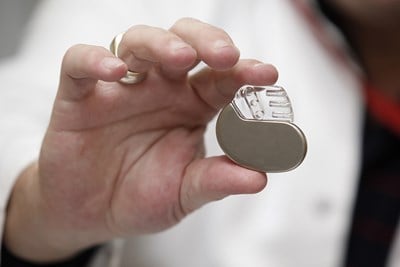The pacemaker is a battery-operated device implanted near the heart and attached to it by wires to monitor the heartbeat. Pacemakers may be used temporarily in an emergency or on a long-term basis. Here are ten terms to help you understand pacemakers better.
- Sinoatrial (SA) node: Your heart consists of four chambers: two upper atria and two lower ventricles. In the right atrium is the sinoatrial (SA) node—a natural "pacemaker" in the heart. Like a mechanical pacemaker, the SA node sends out electrical impulses that induce the atria to contract and send blood down to the ventricles, which contract shortly after the atria. Unfortunately, SA nodes do not always work perfectly. Thus, the need for pacemakers.
- Arrhythmia: There are several types of arrhythmias, or cardiac diseases that cause the heart to beat irregularly. Arrhythmias may be the result of an underlying disease, a side effect of surgery, an imbalance of electrolytes, a heart attack, or some other unexplained cause.
- Tachycardia: Tachycardia is one of the more common forms of arrhythmia that pacemakers are used for. Tachycardia is characterized by episodes in which the heart beats much faster than it should. While the human heartbeat can be considered “healthy” up to 100 beats per minute while resting, tachycardia may cause this number to increase up to 400 beats per minute.
- Bradycardia: Bradycardia is the opposite of tachycardia but is also treatable with a pacemaker when other options have failed. The heartbeats much too slowly—less than 60 beats per minute.
- Atrial fibrillation: The most common arrhythmia is atrial fibrillation. When this occurs, the electric signals from the SA node become irregular, causing the atria to quiver fitfully, allowing blood to pool in the upper chambers, and keeping the atria and ventricles from working together.
- Single chamber pacemaker: Every pacemaker has a series of one to three wires extending from it that are used to connect it to the appropriate number of chambers. A single chamber pacemaker is generally only connected to the right ventricle to promote a proper rhythm in the ventricles when issues like atrial fibrillation are present.
- Dual chamber pacemaker: A dual chamber pacemaker connects to two chambers—an atrium and a ventricle (usually the right). This is used for cardiac issues that are caused by the two halves not beating in tandem. The overriding signal from the pacemaker encourages the sides to beat together.
- Biventricular pacemaker: Also called cardiac resynchronization therapy (CRT), biventricular pacing consists of placing a wire into both ventricles as well as an atrium. This can be used in situations like heart failure, when the two halves of the heart fail to beat in tandem any longer. CRT is a regularly new innovation that has seen a lot of success.
- Demand pacing: Most pacemakers make use of demand pacing. Rather than constantly overriding the SA node’s electrical signal, a pacemaker utilizing demand pacing programming simply monitors the heartbeat; when an irregularity is noticed, the pacemaker kicks in to regulate the beats.
- Rate-responsive pacing: When demand pacing isn’t appropriate, rate-responsive pacing may be a better option. In addition to the heartbeat, the pacemaker monitors temperature, respiration, and other cues that indicate an increase in activity level—which cues the pacemaker to increase the heartbeat to a level appropriate with the amount of activity occurring.



